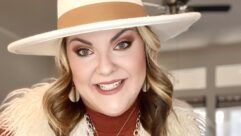
SVC Podcast – Show Notes – Show 162-2
In this edition of the SVC Podcast, SVC Contributing Editor Bennett Liles finishes his conversation with Patrick Baltzell, sound designer and front of house mixer on the Democratic and Republican conventions for ATK Audiotek. Pat takes us behind the scenes to examine the disappearing podiums, dealing with extreme security measures and technical backups for the live conventions shows this year.
For Part 1
Links of interest:
- ATK Audiotek, production company for the 2016 Superbowl, Emmy Awards and the political conventions.
- The Powersoft Armonia Pro Audio Suite software used for amplifier remote control and monitoring
- DiGiCo SD7 front of house mixer used by Pat Baltzell on both conventions
Download Podcast Here:
https://s3.amazonaws.com/nb-svc/public/public/161-2_Conventions_Baltzell…
From Sound & Video Contractor Magazine, this is the SVC Podcast with Pat Baltzell of ATK Audiotek. Show notes and equipment links for the podcast are on the web site of Sound & Video Contractor Magazine at svconline.com.
ATK Audiotek and Pat Baltzell, sound designer and front of house mixer handled the Academy Awards, the Super Bowl and most recently, the Democratic and Republican conventions. Pat is here to finish his story about the political conventions and what it’s like to be the guy out front for sound on these high stakes shows. That’s next up on the SVC Podcast.
Pat, it’s nice to have you back with us on the SVC Podcast fresh from this summer’s political conventions where you were they guy with his hands on the faders out front. You’ve done the Super Bowl, Academy Awards and much more so it’s great to have you here to tell us about the conventions.
My pleasure.
The democratic and republican conventions. How long did you have from the time you got access to the floor and the stage until the opening gavel on these shows?
The republicans usually take a little more time so we get about three and a half weeks we have onsite from the time we first unload trucks until the opening of the convention. The democrats have gotten a little more efficient with their schedule so they run longer days, so it’s probably two weeks. [Timestamp: 1:35]
That would seem to be a lot of time but there’s a whole lot to do.
There’s more to it than a concert or a music show, for instance, because there’s the press distribution which would not be typical if it were the Grammy Awards or another music show. So we basically have to wire the whole building because it’s a precedent when you think about it. People from all over the world come to cover who’s going to be the next President of the United States. It is newsworthy all around the world. So there are from small radio broadcasters from Asia and South America to all of the primary broadcasters from Europe and North America that cover this thing so we have to provide feeds all over the arena. So that takes a lot of time to distribute fiber and then we run fiber backbones to every floor and then we break out to analog copper feeds with distribution amplifier racks from there to oh god, the count is probably 300 press feeds maybe more – maybe 400 – in locations all over the arena so that when you show up you plug in and I have to provide audio 400 times throughout the arena. So that takes a lot of time. You’re running wires through drop ceilings and creating bridges across concourses and all that. So it takes quite a while. [Timestamp: 2:58]
Add to that all the security involved in these two events. How was it dealing with the security for the crew and the gear?
Everybody has to go through the whole vetting process starting months out because you’re in the room with the next President or in some cases the standing President of the United States. So in the case of Hillary’s convention we had Barack Obama and Joe Biden and Michelle Obama all speak so security is very tight for both the crew and the equipment. There’s bomb-sniffing dogs that have to check every single piece of equipment that goes in the air and for that matter on the ground. So every speaker has to be sniffed by the dogs before it’s attached and flies out up over everybody’s head. [Timestamp: 3:45]
And in Philadelphia you used over a hundred Powersoft K-10 amps.
Correct.
Got to be a good reason for that.
Yes. Well I did mention some of this last week, but the weight of the amplifiers and the ease of tuning in the Armonia software; two primary reasons why I love the Powersoft amplifiers and their reliability. I’ve never had one go down during a project on me and like you said I use hundreds of them on a given project. They’re extremely reliable and versatile and once we put them up in the grid there’s not easy access to them. And on the security issue once the convention starts the most secure place in the whole arena is the catwalks because that’s obviously a place where somebody with nefarious intentions, that’s a good place to be hanging out. So the Secret Service basically shut down the catwalks and the grid once the convention starts. So I need amplifiers that do not require my attention once they’re up there. [Timestamp: 4:52]
And we’ve talked about the power output to weight aspect. Another big advantage.
Yes.
Another thing on the conventions that look pretty cool were the motorized podiums.
Yes.
You’ve rehearsed with those and so how do they work?
It’s been done two different ways over the years because as I mentioned this is my 14th and 15th national conventions. Primarily the podium itself goes up and down and it actually has to, in some cases, disappear underneath the stage. That would be for a big performance where you have a big choir or in Hillary’s convention we had that tribute piece, that Broadway Cares performance of What the World Needs Now is Love that they did for the Pulse Club Massacre. It was a fundraising event. We staged that so we had 44 singers on stage. So there’s times when the entire lectern needs to vanish underneath the stage. So the lectern needs to be telescoping, number one, so it’s like a two-part sleeve that is motorized with memories. They’ve gotten better over the years. We used to just have to watch them and put tape marks on the side. And I always have my guy operate it because they try to put a carpenter or stagehand or automation guy on it. But I insist that it be one of my crew that I’ve chosen because the conventions go for 6-7 hours and it’s hard to stay focused on dozens and dozens of people that are short and tall and in between coming out there unless your job depends on it. So I’ve found over the years having a carpenter do it, they lose focus and then the mic’s in the wrong place, the lectern’s too high or it’s too low. So I insist that it be one of my hand-chosen guys. So anyway, the lectern is telescoping so that’s one of the adjustments. And that’s typically about a 12 or 14-inch travel which could accommodate quite a variance in speaker height. And then the podium itself is on a platform that’s also motorized that can go up and down. Sometimes it can go up above the level of the stage and of course it goes all the way down when it needs to disappear. And there’s usually a slip door that then comes up and fills in the hole where the lectern was so now you have a stage where you can do a dance number. Or when the nominee accepts and the balloon drop happens they like a big, wide-open stage because the kids and the family and the grandmoms and all come up for that celebration moment and they like to have the lectern vanish for that. [Timestamp: 7:31]
There’s a lot of audience reaction and participation on the convention shows. To pick up that crowd without causing the stage mics to sound like they’re coming out of a barrel has always got to be a challenge.
Yes. I always go home at the end – I mean we go until midnight, but I go back and just put on CNN or Fox News or something to just get a snippet of like a QC – quality control – check on the work that I did that night. But to be honest it’s a very fine line because I do the best I can to manage the sound in the building and optimize the performance of the PA system. I take a lot of time during the measurement phase. I take 8-10 hours sometimes with a dozen mics spread out all over to make sure that every zone is plus or minus a couple of dB and that the intelligibility is the same everywhere. So I try to get the room as stable as possible for the worst case. A lot of the politicians have big voices; they’re trained speakers so they know how to project. Some of them don’t. They have mothers of the guys killed in Benghazi and people like that that are not professional speakers so they speak quite confidentially. So that’s the challenge. So I do the best I can to make sure it’s intelligible everywhere but if the broadcast mixer in the truck goes heavy on the audience mics to reach for a response – maybe the speech has moments that are deliberately intended to evoke audience response – then he’s going to lean on the audience mics. Well, then you’re going to hear the sound of the PA system if he goes overboard with that. So by and large the professional speakers, the Newt Gingriches and Bill Clintons and Michelle Obama, they sound really good and I can tell that you hear the audience, but it doesn’t sound like the bottom of the barrel like you mentioned or roomy or washed out. But once in a while if they’re really reaching the guy in the truck, because the director is saying give them more applause or get – they’re doing a “U-S-A!” or one of those chants and they want to reach for it. Then, you know, sometimes in my opinion there’s too much audience mics. Now on the award shows we sweeten them so it’s not a problem. So we always have a sweetener that’s got artificial laughs, claps, applause – all of that – so we don’t have to rely on the audience mics entirely. You can kind of cheat and sweeten it with the guy that’s got all the sounds in his computer so you kind of know what’s coming. But in the political events you can’t really do that because you don’t know what they’re going to say. When they start chanting “Lock her up!” about Hillary at Trump’s convention you don’t have that necessarily in your database of audience sounds. You wouldn’t have that and you wouldn’t have “U-S-A!” and “Four more years!” and all these things that are kind of unique to political events. So you’ve kind of got to play it safe and use real audience mics. And sometimes it works and sometimes you can hear him battling me on the air. But hopefully there’s not much of that and that’s why they hire me back. [Timestamp: 10:49]
Well, they keep going with what works but do the sound levels tend to creep up? Do you have to watch that?
Well they – it’s interesting. They do and these are conventions so they’re noisy. There’s interviews. There’s shows within shows within shows on the floor of the convention, particularly day one is kind of – everybody’s kind of getting in, going. Day two, I mean you’ve got Stephen Colbert, you’ve got Wolf Blitzer and everybody underneath them is on the floor grabbing politicians for interviews. So the noise level of the crowd is substantial. It’s not a captive audience like you might think until you get to the keynote speakers on day three and four. When you get to Michelle Obama and Joe Biden and Jill Biden then you can hear a pin drop. Chelsea Clinton, she was very, very quiet. Extremely quiet. I’ve never worked with her before until this and she didn’t rehearse so it was kind of like okay, you get what you get. And she was very quietly speaking. But fortunately because it’s Chelsea Clinton you could hear a pin drop. And all the interviews stopped and the whole audience is now quiet and captive fortunately. But that varies wildly throughout the convention depending on who’s up there speaking. If it’s the junior senator from Arkansas who’s just on the radar as a politician then the noise floor is very high and nobody’s paying attention to him except the delegation from Arkansas of course. [Timestamp: 12:26]
And of course, hopefully you’re in the best place to hear everything.
I’m in a perfect place because I’m up above the crowd on the top of that platform right looking down the barrel of two giant 16-box speaker arrays. So no, I’m in a great position. [Timestamp: 12:42]
No rest for the weary so what’s coming up next for ATK Audiotek? You’ve always got big things to do.
Yep. Right now I’m working on the Emmy Awards. I’m doing a project, it’s an opening in Washington, D.C. On the Smithsonian Mall there’s a new National Museum of African American History. So we’re doing a very interesting televised project that’s the gala commemorating the grand opening of this brand new museum. And it’s a whole history from slavery to African music to Harlem, the Cotton Club, popular music, sports, gospel music. All these things are part of this museum and we’re capturing all of this in this television show. So that’s next month. Then the Country Music Awards is the following month in Nashville so I’m working on that. So yeah, lots of good stuff coming down the pike. [Timestamp: 13:38]
And not exactly low profile either. Thanks for being here with us. Pat Baltzell, sound designer and front of house mixer for, among many other things, the Democratic and Republican conventions. Wow.
And whoever wins I get to see them one more time for their inauguration on January 20th when they get sworn in.
Whenever the big stuff happens you’ll be bringing out the house sound. Thanks for giving us the details on this one.
It was my pleasure, Bennett.
Thank you for joining us for the SVC Podcast with Pat Baltzell. Show notes and equipment links are on the website of Sound & Video Contractor Magazine at svconline.com. Be back with us next time for the SVC Podcast.










